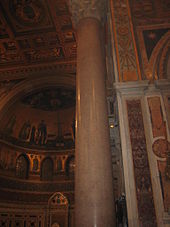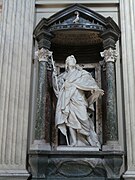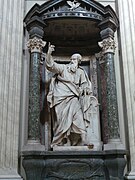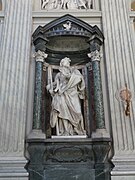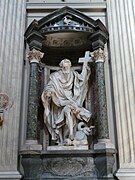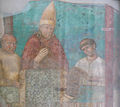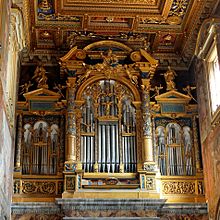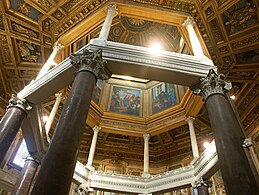Lateran Basilica
| Lateran Basilica of St. John Lateran |
|
|---|---|
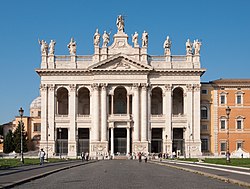 Lateran Basilica - main facade |
|
| Data | |
| place | Rome |
| Coordinates | 41 ° 53 '9 " N , 12 ° 30' 21" E |
| particularities | |
|
Papale Arcibasilica Patriarcale Maggiore Cattedrale Arcipretale del Santissimo Salvatore e dei Santi Giovanni Battista ed Evangelista al Laterano PAPALIS ARCHIBASILICA PATRIARCHALIS MAIOR CATHEDRALIS ARCIPRETALIS SANCTISSIMI SALVATORIS ET SANCTORVM IOHANNIS BAPTISTAE ET EVANGELISTAE APVD LATERANVM, OMNIVM VRBIS ET ORBIS ECCLESIARVM MATER ET CAPVT |
|
The Lateran Basilica , Italian Basilica of San Giovanni in Laterano , is the cathedral of the diocese of Rome , one of the seven pilgrimage churches and one of the five papal basilicas of Rome. Its Latin name is Archibasilica Sanctissimi Salvatoris et Sanctorum Iohannis Baptistae et Evangelistae in Laterano ("Archbasilica of the Most Holy Redeemer, St. John the Baptist and St. John the Evangelist in Lateran"). The basilica is part of the building complex of the Lateran in the district of Monti in the center of Rome , which since the time of Constantine I. the official residence of the popes is. An ancient baptistery belongs to the Lateran basilica .
As the episcopal church of Rome, the Lateran basilica is the highest-ranking of the four basilicae maiores in Rome. The current archpriest is Cardinal Angelo De Donatis . The office of Honorary Canon of St. John Lateran falls to the President of France .
history
Pre-Christian history
The property was named after the original owners, the Roman Laterani family. It was apparently confiscated by Nero in 65 due to Plautius Lateran's involvement in the Pisonian conspiracy . In 161, Marcus Aurelius built a palace there. At the end of the 2nd century, Emperor Septimius Severus gave part of the possessions back to Titus Sextius Magius Lateranus .
Development under Emperor Constantine
There are different versions of the actual founding of the Church by Constantine the Great, over which historians disagree. It has been proven that at the beginning of the 4th century the quarters of the elite troops, the equites singulares Augusti of the emperor Maxentius , were on the Aurelian wall . After Konstantin had defeated Maxentius in 312, he ordered the riders' barracks to be razed as part of a damnatio memoriae , and at this point he left a monumental basilica and an accompanying basilica for the Christian community and “as a token of his appreciation for his heavenly protector” Build a baptistery.
According to another version, Fausta , Constantine's wife and sister of Maxentius, owned a house with a domus ecclesia (a Christian meeting place and place of prayer) on the same property that she had given to the Bishop of Rome , Miltiades , for a bishops' council in 313 .
From what point in time the Lateran was the residence of the Roman bishops is still controversial in research. It was right next to the Sessorium Imperial Palace , built in the 3rd century , the residence of Constantine's mother Helena , who still exists in parts in the Church of Santa Croce in Gerusalemme . Of the three major Constantine churches, the Lateran basilica was located within the city walls and thus served as a cathedral. The Peter's Basilica and St. Paul Outside the Walls were over the graves of the apostles outside the city. That is why the church is still the Pope's episcopal church and as such bears the honorary title Omnium urbis et orbis ecclesiarum mater et caput (“Mother and Head of all Churches in Rome and the world”), which is why it is the highest-ranking Patriarchal Basilica . The Lateran Basilica was originally built by Pope I. Silvester Christ , the Redeemer ( Latin Salvator ), consecrated and later also the patronage of St. John the Baptist ( Italian San Giovanni assumed), so is their Italian name of St. John Lateran .
Middle Ages and Early Modern Times
In the 5th century the buildings on the Lateran were repeatedly plundered by Teutons , badly damaged by an earthquake in 896, but repeatedly repaired. In 897 the so-called synod of corpses took place here, at which Pope Stephen VI. sentenced his predecessor Formosus posthumously, desecrated the corpse and finally had him thrown into the Tiber.
The following councils took place in the Lateran:
- First Lateran Council (1123)
- Second Lateran Council (1139)
- Third Lateran Council (1179)
- Fourth Lateran Council (1215)
- Fifth Lateran Council (1512-1517)
In the 14th century, San Giovanni was badly damaged by two fires and was rebuilt and renewed both times. Next to the church was the papal palace until 1309, the remains of which still exist in the Sancta Sanctorum chapel and the holy staircase , the Scala Santa. After the popes moved their residence first to Avignon and later to the Vatican , the Lateran Basilica was neglected.
In 1586, today's Lateran Palace, which was attached to the church, was rebuilt as the papal summer residence. Here, the architect built Domenico Fontana , the Benediction Loggia in front of the side entrance to the transept.
The dilapidated church was stabilized in 1646 by Francesco Borromini for the Holy Year 1650 and made baroque. At the request of Innocent X , the original shape as a five-aisled basilica was retained, but the side aisles had to be demolished and completely rebuilt. In the main nave, he reduced the original design with 14 arcades over enormous late antique columns to 5 arches per side with wall panels in between. In the walled-in niches he had large aedicules built, in which colossal marble statues of the twelve apostles were placed up to the beginning of the 18th century.
St. Peter
St. Paul
St. Andrew
Saint James the Elder
St. Thomas
St. John
St. Philip
St. Bartholomew
St. Matthew
St. Thaddeus
St. Simon
The main facade was unadorned and was therefore clad with an ephemeral display for special festivities. In the 1730s, the main facade was built by Alessandro Galilei .
Modern times
The Popes were crowned in the Lateran until the 19th century.
In the middle and at the end of the 19th century, extensive alterations and restorations took place, which significantly affected the medieval structure of the choir with its mosaics, which had been preserved until then.
In 1929, the Lateran Treaty of Vatican City secured statehood, and u. a. the Lateran and Castel Gandolfo the status of an extraterritorial possession of the Holy See .
Building description
Exterior
The benediction loggia built by Domenico Fontana around 1586 on the north facade of the Lateran Palace is an impressive double arcade with a high arch and a large span.
The monumental main facade by Alessandro Galilei is crowned by colossal figures up to seven meters high. In the middle you can see Jesus , on the left stands John the Baptist, on the right the Evangelist John , next to them are statues of the most important Doctors of the Church .
The doors of the main portal are from the ancient curia in the Roman Forum ; as spolia they demonstrate the transition and continuity of rule in Rome in the papacy.
Main nave
The core of the five-nave pillar basilica goes back to Constantine in the 4th century. However, as mentioned, the church has been rebuilt and renovated several times over the centuries and in its current form reflects particularly the revisions of the 16th and 17th centuries; the choir with apse and mosaics dates from the late 19th century.
The main nave is the result of Borromini's Baroque transformation. It is fluted e pilasters of Kompositordnung and five large arcades divided. Rectangular windows open over the arcades. The wide pillars between the arches are decorated in the lower area with the monumental figures of the apostles; these were created by baroque sculptors such as Camillo Rusconi (1658–1728), Pierre Legros (1666–1719) and Pierre Monnot (1657–1733). Above in the middle wall area reliefs by Alessandro Algardi (1595–1654) and his students, and at the top between the windows oval, stucco-framed frescoes with depictions of Old Testament prophets . They come from some of the most famous painters of the Italian high and late baroque, including Sebastiano Conca , Pier Leone Ghezzi , Luigi Garzi , Francesco Trevisani , Giuseppe Chiari, Giuseppe Nasini and Marco Benefial .
From before Borromini comes the magnificent mannerist e coffered ceiling , which emerged in the 1560s and the late 18th century under Pius VI. has been restored. The floor of the main nave in the cosmatic style originally goes back to the pontificate of Martin V (1417–31) and was later u. a. restored by Borromini, whereas he created a new floor with optical illusions for the aisles.
On the back of the first pillar on the right is the fragment of a fresco attributed to Giotto , showing Pope Boniface VIII proclaiming the Holy Year 1300. A copy of the complete fresco is preserved in the Biblioteca Ambrosiana .
Choir and apse
The choir , which was expanded in the Middle Ages with the mosaics created by Jacopo Torriti and Jacopo da Camerino on behalf of Nicholas IV in 1288 to 1292 , was opened in 1884 under Pope Leo XIII unfortunately completely demolished and rebuilt by Virginio Vespignani (1808–1882) as a historicist reconstruction . The current mosaics are based on Torriti's originals, but a rather mediocre and somewhat rigid work of the late 19th century that does not come close to the complexity of medieval mosaic art. In addition to the monumental figures of the Virgin Mary and John the Baptist as well as the Apostles Peter , Paul , John and Andrew , the figures of St. Francis of Assisi and Antony of Padua and the original client Nicholas IV (kneeling) added because he belonged to the Franciscan order . Also in the apse is the papal cathedra , it is decorated with mosaics in the Cosmaten style. On the side wall you can see a fresco from the 19th century by Francesco Grandi.
The ciborium

A Gothic ciborium rises above the main altar , which was built in 1851 under Pius IX. has been restored. It contains the relics of the heads of St. Peter and Paul . These were removed from their original resting place, the Sancta Sanctorum , by Urban V. (1362-1370) and moved to the newly built ciborium. The ciborium was created by Giovanni di Stefano in 1367–68 and painted by Barna da Siena with twelve pictures, three on each side. The pictures were later renewed by Antoniazzo Romano : On the side of the main nave you can see the crucifixion , surrounded by the hll. Jakob, Paul, Peter and Andreas, on the opposite side towards the apse you can see the Annunciation and the Coronation of Mary and St. Catherine . The frescoes in the direction of the north transept show a portrait of Mary and the hll. Laurentius , John the Baptist , Stephanus and Johannes Evangelista , in the direction of the south transept, Jesus Christ stands as a good shepherd in the middle, surrounded by the hll. Gregory , Augustine , Hieronymus and Ambrosius .
The transept frescoes
The entire transept was decorated with a large cycle of frescoes between 1597 and 1601 under the direction of Cavalier d'Arpino , stylistically in the transition from late Mannerism to Baroque . Besides Cavalier d'Arpino, the following were involved: his brother Bernardino Cesari , Cristoforo Roncalli ( il Pomarancio ), Cesare Nebbia , Orazio Gentileschi , Giovanni Baglione , Giovan Battista Ricci and Paris Nogari. On the side walls of the transepts, scenes from the life of Constantine the Great and from the founding history of the basilica and figures of church fathers and apostles are depicted . Probably the most important of these frescoes is in the left transept above the sacrament altar (exactly opposite the organ) Cavalier d'Arpino's huge and radiant Ascension of Christ (also Transfiguration ), for which the painter was honored with the Order of Christ . Pomarancio's baptism of Constantine in the right transept is also famous .
Tombs
In the church there are numerous papal tombs, in the Confessio Pope Martin V rests . Through this burial place the first undisputed Pope after the Great Western Schism demonstrates the continuity of the papacy in his Roman episcopal church; in his time the actual burial place of the popes was the Vatican basilica. Others also found their final resting place in the basilica, such as Clemens XII. , from whose time the facade of the church dates, also: Sergius III. , Silvester II. , Sergius IV. , Alexander III. , Clemens XII., Leo XIII. The graves of numerous other popes have been lost.
The apse with the cathedra of the Pope as Bishop of Rome
Annunciation of the first holy year by Boniface VIII in 1300 (fresco fragment by Giotto )
Bronze portal (from the Iulia Curia )
Organs
The main organ
The history of the organ of the Lateran Basilica goes back to the 16th century. In 1597 the construction of a large organ was commissioned, which was built by the organ builder Luca Biagi and completed in 1599. This instrument has been restored and expanded several times. The last extensive restoration was carried out in 1984 by the organ builder Francesco Morettini after the instrument could not be played for almost 50 years. The instrument has a total of 28 stops on two manuals. The pedal is attached. The Roman numerals as register names refer to the pitch .
Disposition of the main organ
|
|
||||||||||||||||||||||||||||||||||||||||||||||||||||||||||||||||||||||||||||||||||||||||||
- Effect register : Rosignolo
The two choir organs
The church also has two choir organs, which were built in 1886 by Nicola Morettini . The Epistle organ has 46 stops on three manuals and pedal, the Gospel organ only 24 stops on two manuals and pedal.
Disposition of the epistle organ
|
|
|
|
||||||||||||||||||||||||||||||||||||||||||||||||||||||||||||||||||||||||||||||||||||||||||||||||||||||||||||||||||||||||||||||||||||||||||||||||||||||||||
- Coupling : II / I, III / I, I / P, II / P, III / P
- Playing aids : combinations , tremulant (whole organ)
Disposition of the gospel organ
|
|
|
||||||||||||||||||||||||||||||||||||||||||||||||||||||||||||||||||||||||||||||||||||
Cloister
The cloister of the monastery of the Lateran Basilica is considered one of the most beautiful in Rome and was built between 1215 and 1232, probably by the artist family Vassalletto. The approximately 36 m long arcades were furnished with richly ornamented, partly twisted columns; they demonstrate cosmatic ornamentation in its purest form. In the middle of the courtyard is a fountain basin from the 9th century.
Remains of the old basilica (before the renovation by Borromini) are attached to the walls, including parts of the tomb of Cardinal Annibaldi della Molara by Arnolfo di Cambio , who died in the 13th century , parts of the former Magdalen ciborium, which today border an old bishopric.
- Some impressions of the cloister:
Baptistery
The octagonal Baptistery of the Lateran today is probably the oldest in Christendom and is considered the “prototype of all baptisteries”. It was probably originally built around the year 315 by Constantine and in the years 432 to 440 under Sixtus III. converted into an octagon. Although it has now been redesigned many times, it still shows some remains of ancient mosaics and the ancient columns made of Egyptian porphyry . A bronze door from the 5th century from the time of the Roman bishop Hilarius has also been preserved. It is one of the last of its kind made in Rome in ancient times.
The murals of today's interior are from the 17th century. They come from Andrea Sacchi (1599–1661). Among other things, the composition of Carlo Maratta's picture , which shows the destruction of the idols by Emperor Constantine, is noteworthy - a completely ahistorical representation.
The baptistery was part of a large complex of chapels dedicated to St. Stephen, St. Hilary and the Holy Cross; they had to give way to the major renovation of the entire complex and can only be seen on old plans and drawings, of which the Biblioteca Vaticana has by far the largest number.
liturgy
The Holy Mass on the feast of the Most Holy Body and Blood of Christ with the Pope takes place in front of the Lateran Basilica. The mass is followed by the Corpus Christi procession to Santa Maria Maggiore. The day of consecration of the Lateran Basilica on November 9th is celebrated as a festival throughout the Catholic Church .
See also
literature
- Peter C. Claussen and Darko Senekovic: S. Giovanni in Laterano. With a contribution by Darko Senekovic about S. Giovanni in Fonte (Corpus cosmatorum II, 2). Franz Steiner Verlag, Stuttgart 2008, ISBN 3-515-09073-8 .
- Walter Buchowiecki: Handbook of the Churches of Rome. 3 volumes, Vienna 1967–1974.
- Roberta Vicchi: The Patriarchal Basilicas of Rome , Scala, Antella (Florence), 1999.
- Johannes Baptist von Toth: The Pope's Cathedral . Herder Verlag, Freiburg - Roma - Vienna 1966.
Web links
- Arthur Barnes: Saint John Lateran . In: Catholic Encyclopedia , Volume 9, Robert Appleton Company, New York 1910.
- Virtual tour of the Lateran Basilica on the Vatican website
- interactive 360 ° tour
- The frescoes by Antoniazzo Romano on ciborium (English)
Individual evidence
- ↑ a b Basilica papale. (No longer available online.) Vicariatus Urbis - Portal of the Diocese of Rome, archived from the original on January 17, 2009 ; Retrieved August 7, 2008 (Italian).
- ↑ The full Latin name is: Papalis archibasilica patriarchalis maior cathedralis arcipetralis Sanctissimi Salvatoris et Sanctorum Ioannis Baptistae et Evangelistae apud Lateranum, omnium urbis et orbis ecclesiarum mater et caput .
- ↑ a b Roberta Vicchi: The patriarchal basilicas of Rome , Scala, Antella (Florence), 1999, pp 64-65.
- ↑ Pedro Barceló : The Roman Empire in the Religious Change of Late Antiquity. Emperor and bishops in conflict . Verlag Friedrich Pustet, Regensburg 2013, ISBN 978-3-7917-2529-1 , p. 47.
- ↑ The Transfiguration of the Lord . In: Ökumenisches Heiligenlexikon (heiligenlexikon.de).
- ↑ a b Roberta Vicchi: The Patriarchal Rome , Scala, Antella (Florence), 1999, p 66th
- ↑ Roberta Vicchi: The patriarchal basilicas of Rome , Scala, Antella (Florence), 1999, p 69th
- ↑ a b c d e Roberta Vicchi: Die Patriarchalbasiliken Roms , Scala, Antella (Florence), 1999, p. 74.
- ↑ z. B. in 1729 on the occasion of the canonization of John Nepomuk . This facade is shown on a copper engraving owned by the Albertina in Vienna.
- ↑ Roberta Vicchi: Die Patriarchalbasiliken Roms , Scala, Antella (Florence), 1999, pp. 78–79.
- ↑ a b c d e f g Roberta Vicchi: Die Patriarchalbasiliken Roms , Scala, Antella (Florence), 1999, pp. 79-80.
- ↑ a b Roberta Vicchi: The Patriarchal Rome , Scala, Antella (Florence), 1999, p 73rd
- ↑ a b c Roberta Vicchi: The Patriarchal Rome , Scala, Antella (Florence), 1999, p 78th
- ↑ Roberta Vicchi: The patriarchal basilicas of Rome , Scala, Antella (Florence), 1999, pp 75-76, here: 76th
- ↑ Roberta Vicchi: The patriarchal basilicas of Rome , Scala, Antella (Florence), 1999, p 64th
- ↑ More information on the organ of the Lateran Basilica ( Memento of the original from April 21, 2014 in the Internet Archive ) Info: The archive link was inserted automatically and has not yet been checked. Please check the original and archive link according to the instructions and then remove this notice.


